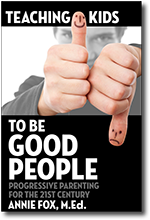|
|
January 23, 2013
I originally wrote a version of this article for TakePart.com where I contribute a weekly education post. Check out the rest of my articles there.
 ... because it's not helping Do you know the Yiddish verb, to kvetch? On the surface it simply means: to complain. As in, “Just get your homework done and stop kvetching already.” But actually, kvetching goes beyond complaining into the realm of eternal dissatisfaction where nothing is ever good enough and it becomes one’s mission in life to let everyone know exactly where and why things don’t measure up.
No one is a happy camper all the time. It’s not realistic to expect to be and it’s certainly not a requirement. And yet we keep on expecting it, don’t we? Especially those of us fortunate enough to live pretty well. When reality doesn’t meet our impossible standards we may not be able to keep our mouth shut. Of course, speaking up can be the first step toward positive change. It can also help build self-respect and healthier relationships. Which is why, when a teen bitterly complains to me about a friend who isn’t acting like one, I counsel the teen to go on record and tell the friend, “This isn’t OK and here’s why.”
What’s the alternative? Staying silent? That’s not likely to improve a relationship. So, yes, sometimes we need to complain.
But what do you do if your child constantly complains?
- “That’s stupid!”
- “This isn’t what I wanted!”
- “You can’t make me!”
- “That’s unfair!”
- “This sucks!”
What if your child’s negative attitude permeates everything?
I realize that finding fault may be an essential part of becoming a young adult. Unlike little kids who try to emulate their godlike parents, t(w)eens have begun the hard work of establishing their own unique identity, as different from us parents as imaginable. Teen negativity is often a display of independence, plain and simple. This may help us understand where it’s coming from, even though it doesn’t make the attitude any more fun to be around.
If your kid has gotten into the habit of grousing s/he may outgrow it. (We can always hope!) But hope isn’t an especially effective parenting strategy and a negative attitude can pollute your family life. Rather than lashing out in frustration or suffering silently, I suggest a direct intervention that will, at the very least, give your child insight into what it’s like to live with constant griping. I tackle the issue in my book Teaching Kids to Be Good People. This brief synopsis offers some tips on how to start turning around a negative attitude:
Conversation That Counts
Some complaints are helpful; some aren’t. Discuss with your child the concept of complaining. Point out that some complaints are helpful. (“The roof is leaking on my head.” “We’re out of toothpaste again.”) These can become action points. Other types of complaints aren’t intended to be helpful. They’re simply a chance to vent or to blame. (“This assignment is boring!” “Why did I get her for a sister?” “You kids never do anything right!”)
Reverse role-play. Tell your child that you’re going to “act out” one (unhelpful) complaint that you regularly hear from him/her. Be realistic in your dramatization, but not unkind. Remember you’re trying to teach, not wound. Now ask your child to act out an unhelpful complaint s/he regularly hears from you. (Yes, this lesson is a two-way street.)
How bad is the habit we’ve gotten into? Discuss the regular grumbling and whining amongst family members that aren’t meant to be helpful. What impact does it have? What might family life be different if there were less complaining?
Make a change. Challenge each family member to catch him/herself (not anyone else) in the act of complaining and try one of these responses instead:
a) Communicate directly about what needs to be done.
b) Skip the complaint and do some or all of what needs to be done (on your own).
c) Change what you can change and change your attitude about the rest.
Call another family meeting in a week to report on the progress everyone has made in creating a more cooperative atmosphere. We’re into a new year. How about working together to keep moving in a positive direction? It’s worth a try.

December 10, 2012
by Carolyn Fallon
Carolyn is a 20-something year old with a passion for life, fitness and overall well-being. She is an avid cycler, golfer and has known to bust some serious moves on the dance floor. To learn more about Carolyn, please check out her blog.
I never paid attention to the topic of Type 2 Diabetes. All of that changed when my little cousin was diagnosed. As I have recently started on my own journey to live a healthier life, it has become even more important to me that I help all my cousins learn how to be healthier. Because the two most common causes of Type 2 Diabetes are obesity and lack of physical activity, I’ve been helping my cousins get on a healthier track through tips on nutrition and exercise.
Dietary Habits
The typical mantra is that anything that tastes good tends to be bad for you. Although this may seem true, it doesn’t have to be! My cousins love their junk food. To prevent them from feeling totally deprived of the things they liked, I found creative ways to allow them to indulge in these foods in small moderation. I’m also helping them find ways to make healthy foods taste yummy too. Here are some popular changes I made that will work for you and your family too:
– add grilled vegetables to any meal and you get great flavor and large variety
– add fruit to meals. (Cut ’em into fun shapes!) By getting my cousins involved in making smoothies, etc. they were way more accepting of fruit in general.
– switch from white flour bread to whole grains-products
– use mashed cauliflower instead of potatoes
– use spaghetti squash instead of pasta noodles
There are so many ways you can get kids to start eating healthy if you are willing to get a little creative.
 Get moving!
Get Moving!
It’s so important to get kids in the habit of being regularly active. My cousins tended to spend a majority of their time in front of the TV. To get them excited about exercise, I had to get creative. I found ways to make being active seem like a game instead of just getting exercise. Now we are…
Jumping Rope – A fun activity that many kids enjoy, and can be done alone or with others. We like to do jump rope competitions, or do large-group jump rope games too.
Swimming – Check out the public pool at your local YMCA or community center. Then get in the water with the kids! We do “Olympic trials” for the different kinds of strokes and we also play fun, calorie burning games like Marco Polo and water volleyball. Swimming often appeals to overweight kids because the buoyancy of the water takes the weight off of their joints. It also helps to build cardiovascular strength and endurance, which is good for all age people!
Running or Jogging – Most kids love to run. They may love it more if you make it competitive. My cousins and I like to do timed-races against each other, or our own time. We also play games that involve running, such as tag, Capture the Flag, soccer, kickball, etc.
Doing Yoga – Many kids find yoga to be a rewarding activity that helps them become more flexible and promotes endurance. My cousins were hesitant to try it, but once they got started, they really liked learning the different poses.
Be proactive! It’s scary to think that my little cousin is facing Type 2 Diabetes at such a young age. According to St. Joseph’s Hospital Cardiac Center, potential complications can include such things as eye problems or blindness, heart disease, stroke, neurological problems, and more. With so many possible serious consequences, it’s important that today’s families work together for better health that will help prevent the spread of this epidemic.

November 27, 2012
I originally wrote this article for TakePart.com where I write a weekly education post. Check out the rest of my articles there.
 Get the message? Got it? Good! Whenever I communicate from a school stage or from my computer, I tell students that our choices should reflect the kind of people we really are. Most of us are good people who care about others. We have a strong sense of fairness. We like to be helpful. We try to understand the other person’s point of view.
Very few of us are truly “mean.” And yet, we often exhibit downright mean behavior (online and off). Whenever I get the chance, I challenge students to think about why that’s the case. I also challenge them to stand up for what’s right, acknowledging that it’s not always easy, especially when no one is standing with you.
Most kids older than the age of five, really do know the difference between right and wrong. But they don’t always do the right thing. Our 21st-century culture of cruelty coupled with a sense of entitlement has taught kids (and many adults) that looking out for anyone but themselves is a sign of weakness.
More: What Every Parent Should Know: How to Help Your Kids Deal With Peer Conflicts at School
Going out of one’s way to be nice to a popular kid, however, will likely earn a student some popularity points of his/her own. But being kind to an “underdog,” especially when popular kids are watching, well, that can be a high-risk move. So can turning down a demand from another student to copy from one’s test paper or refusing to cheat in other ways. And so, kids may feel stuck between their natural inclinations to do the right thing vs. doing whatever it takes to be liked or to get ahead.
We’ve taken a tunnel vision approach to school for long enough, with most of our resources going toward test taking. What’s the point of education without a focus on improving one’s character? Parents and teachers need to make a concerted effort to help students develop the social courage it takes to stand up and be moral leaders. How? Well, here’s an excerpt from my book Teaching Kids to Be Good People, that shows a simple way for us to begin lessons in social courage.
Share this quote with students: “The time is always right to do what is right.” — Martin Luther King, Jr.
Ask, “What do you think about this? Is it true? Too simplistic?”
Talk about a time when you or someone else was being treated unfairly and you stepped up and did the right thing. What happened?
Talk about a time when you didn’t help promote respect, peace, and fairness. What held you back?
Create a challenge to increase acts of social courage. You’ll need paper strips (11 x 2 inches), tape, and a pen.
- Think about a time you stepped up and did the right thing when someone needed a friend or a message of peace. Write a sentence about what you did on a strip of paper and sign your name.
- Connect your strip with someone else’s and create “links” using tape.
- Got more than one act of social courage? Make another link!
Each day keep adding to the chain by actively looking for opportunities to be “brave” in situations where someone needs to do the right thing. As a group, talk about any positive changes you notice in yourself, your family, your school.

November 24, 2012
I just got an(other) email from a teen being tormented by rumors. This stuff makes me angry and frustrated and sad. I have a pretty clear sense of how it makes the kids who’ve been targeted feel…. in a word, powerless! And while it’s true no one has the power to un-do a rumor that’s out there, if you or someone you know is suffering from the damage of a rumor, please read on. You are not powerless.
 Why are they spreading these lies? Hey Terra,
There are people spreading rumours at my school saying I had sex with my boyfriend behind the building. I don’t know how it started, and it’s not true! This is horrible and it’s hurting me and my boyfriend a lot! I am getting many harsh words and looks from people I don’t even know 🙁 What am I supposed to do ? Help me please!!!!!!
Lost and Hurting
Dear Lost and Hurting,
I’m really sorry people are being cruel to you and to your boyfriend. People who spread hurtful lies lack self-confidence and compassion. What can you do about what they’re saying? Well, unfortunately, you can’t un-do the rumor. It’s out there. You also can’t un-do any assumptions people have made about you and your boyfriend. What you CAN do is:
- Hold on to your self-respect.
- Hold your head high because you know that you’ve done nothing to be ashamed of.
- Try not to let them upset you with their “harsh words and looks.” I know that’s not always easy, but you impress me as a girl who is strong and self-confident, so work on staying in control of your emotions.
- Do not talk to anyone about the rumors or about the people who are spreading them. That would only increase the “warfare.” It’s not helpful. Don’t go there.
- If someone says something to you, look them in the eye and simply and calmly say, “That’s not true.” No yelling. No trying to convince anyone of anything. Just state the fact: “That’s not true.” Then end your part of the conversation.
Hopefully this “social garbage” (which is exactly what rumors are) will fade away soon. Your real friends will stick with you. If this garbage doesn’t fade away and you continue to be harassed, please talk with the school counselor and/or your parents.
I hope this helps.
Oh, and read this blog of mine about teen rumors.
In friendship,
Terra
She wrote right back:
Thank you so much Terra!!!! I’m really grateful! 🙂
Then so did I:
I’m glad to know that I’ve helped in some way. Enjoy the rest of your holiday weekend. And on Sunday night, re-read my email, especially the things you CAN do, so if the garbage rumors continue on Monday, you’ll know how to take care of yourself.
In friendship,
Terra
Ninety-nine percent of the time I get email about rumors, it’s from the person being victimized. But that’s just one side of the story, isn’t it? We all know that rumors go nowhere without many willing mouths (and fingers) to spread them. If you’ve spread a hurtful rumor, (whether you started it or not) and you now regret the pain you caused, that’s a good place to start thinking about rumors and all of this stuff. You can’t un-do what you did, but you’re not powerless. You can still make things better. Got some ideas how?
 — Older Posts »
| |















